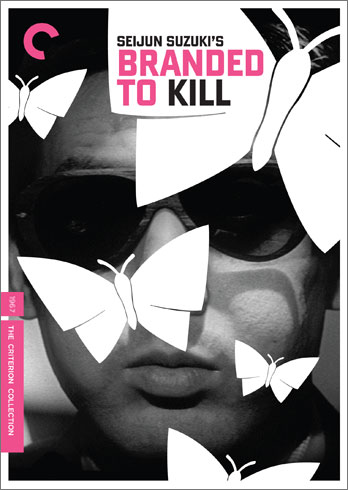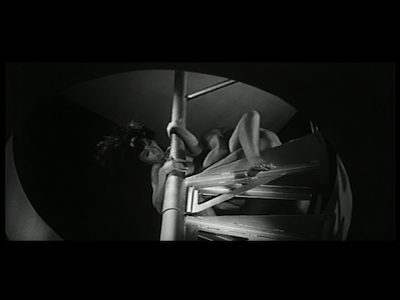"Beast needs beast. That is the beast way. You and I are beasts."

Goro Hanada is the #3 professional killer in Japan. He is a cold, calculated criminal, with all the kinks and emotional distancing that such a job requires. He's married, and after a job, he and his wife rut like animals, spurred on by Hanada's personal fetish: he is invigorated by the smell of boiling rice. Staying alive in the underworld is all down to rank, and so is getting killed. You can't get respected if you don't measure up, but when you rank high, other assassins may come gunning for you. How you get to be #1 is a mystery. Some say the man at the top doesn't really exist, he's just a myth.
The movie is Branded to Kill, and the man who embodies this murderous ideal is Joe Shishido, the unconventional matinee idol with the chipmunk cheeks. He plays Hanada as a cool customer, watching everything, saying little. It's a role he's played before, including several times for director Seijun Suzuki. You could say this is their joint masterpiece, the perfect crystallization of Suzuki's jazzy style and cynical worldview. His disjointed narrative manner had grown so jagged by this point, Suzuki was actually fired from the film during production. While the studio's claims that the movie had become "incomprehensible" don't really hold water, one does have to stay alert while watching Hanada run from his rivals. Suzuki and editor Matsuo Tanji's rapid cutting, some two decades before MTV would popularize similar techniques, removes all the cushioning between individual moments. If you look away to check your phone or play with your cat, you might miss something. (I know both of these to be true from experience!)

At the start of Branded to Kill, Hanada agrees to help a friend with a job. The other gunman has fallen on hard times and needs to prove he can be trusted. He and Hanada are supposed to escort an important person (Koji Nanbara) with a price on his head from the airport. Along the way, they are attacked. Hanada and the mark make it out alive, Hanada's friend is not so lucky.
Shortly after this deadly outing, Hanada meets Misako, a dangerous woman with a death wish. Played by actress Annu Mari, she bears an uncanny resemblance to Chiaki Kuriyama, and she could have easily been on Quentin Tarantino's mind when casting Kuriyama as Gogo Yubara in Kill Bill . Her poison needle routine, and the way these sharp objects symbolically upend traditional sexual imagery, may have also been an inspiration for the schoolgirl killer in Takashi Miike's Fudoh: The New Generation
. Her poison needle routine, and the way these sharp objects symbolically upend traditional sexual imagery, may have also been an inspiration for the schoolgirl killer in Takashi Miike's Fudoh: The New Generation (though, naturally, Miike takes the delivery method to its most gruesome extreme, having the girl shoot the needles from her crotch). Suzuki displays Misako as a girl who almost literally has a rain cloud following her around. She and Hanada meet in the pouring rain, and her appearances are often accompanied by torrents of water, a signal of both fertility and change.
(though, naturally, Miike takes the delivery method to its most gruesome extreme, having the girl shoot the needles from her crotch). Suzuki displays Misako as a girl who almost literally has a rain cloud following her around. She and Hanada meet in the pouring rain, and her appearances are often accompanied by torrents of water, a signal of both fertility and change.

She brings both to Hanada, though he must struggle for the first and the second is foisted on him. Misako convinces him to take a nearly impossible job, and cruel happenstance causes him to fail. This means Hanada loses his rank and is marked for death. Both Misako and his wife (Mariko Ogawa) will try to kill him, blaming "the Organization" for forcing their hands. Hanada begins to suspect a greater conspiracy, and to save his own life, he must kill #1 and take his place.
This proves more difficult when the identity of the top killer is revealed. The trick this assassin uses most often is isolating the target and wearing him or her down. Hanada is placed in a cocoon, as it were, forced to wait out his would-be murderer, a task that taxes him mentally and physically. Suzuki is pushing his protagonist to transform, and butterflies, which are common symbols of metamorphoses, are everywhere. One is the cause of Hanada's failure; Misako also decorates her home with butterfly carcasses. Her signature pins are used to stick them to her wall. At one point in his struggle, when Hanada incorrectly assumes he has made it out of the gauntlet, he sees a battleship with a deck covered in planes. They look like butterflies ready to break free, but they only exist to remind Hanada that he is still a caterpillar crawling on the ground.

Branded to Kill is full of such visual flourishes, and Suzuki especially lends his creative mind to coming up with new ways to stage the sex and violence that make his film such a lurid pleasure. Hanada and his wife have a marathon love-making session in their apartment, each jump cut showing them in a different position. Likewise, each hit that Hanada undertakes before his mishap is increasingly inventive. Handa must kill three targets one after the other, and each time, he comes up with a new way to reach the victim without being seen. It's a famous sequence, best encountered without any foreknowledge so as to best experience the dark humor and gory punchlines.

Success in Branded to Kill is weighed on a rigged scale. Hanada submits himself to his passion for Misako, and he muscles up to tussle with #1, but in each case, his body is more treacherous than any of his colleagues. The desire for the flesh and the desire for fame undo Suzuki's hero. At the start of the film, a professional rule is offered: "Booze and broads kill killers." The true assassin surrenders no control, he masters his own impulses. In this, the success of the filmmaker is clear. His bosses may not have gotten what he was after, but Seijun Suzuki has marshaled the inherent chaos of Hanada's bloody lifestyle and pushed it as far as it can go. In doing so, he provides a way for Branded to Kill's audience to experience the intensity of the moment while also witnessing how such heat can melt the ice in even the coldest murderer's veins. Branded to Kill is exhilarating and strange, and yet never random. Suzuki is perfectly devoted to his own aesthetic intentions, and as the top gunslinger informs his #3, that is how you get to be #1: wear down all opposition with a dogged dedication to your own end goal.

Please Note: The screengrabs here are from the original Criterion disc released in 1999. The new Blu-Ray of Branded to Kill is better in every way imaginable. The image is sharper, brighter, and full of more detail than was apparent on the now ancient first release. Jumping from watching the BD to putting the old disc in my computer was like stepping off of a sunny beach and into a smoke-filled house. The difference is immediately apparent, so do yourself a favor and go for the upgrade, be it the Blu-Ray or the new DVD version. Look for either with the cover at the top of this post!

This disc was provided by the Criterion Collection for purposes of review.

No comments:
Post a Comment